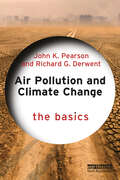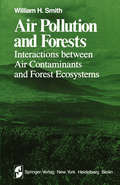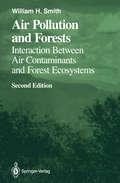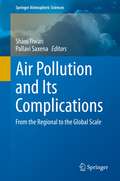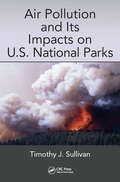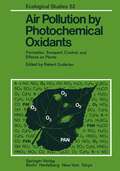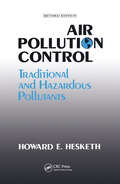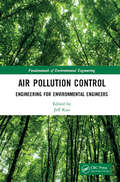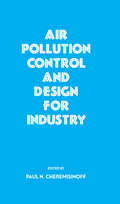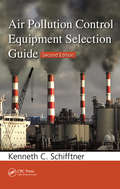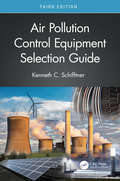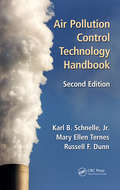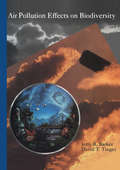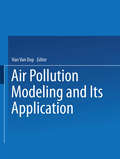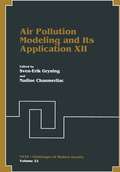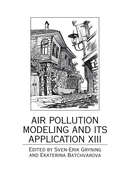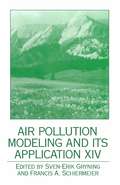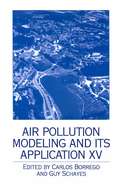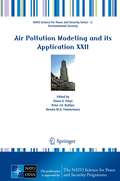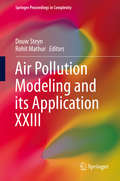- Table View
- List View
Air Pollution and Climate Change: The Basics (The Basics)
by John K. Pearson Richard DerwentThis book identifies four key forms of air pollution: indoor, urban, regional and global. It discusses how these four types of pollution are manifest in today’s society and examines the scientific and policy challenges that stand in the way of progress. Written in a style that balances scientific underpinnings with accessible language, Pearson and Derwent examine the sources and historical context of air pollutants, before dedicating a chapter to each of the key forms. Armed with these basics, they begin to address the challenges faced by improving indoor, urban and regional air quality, whilst reducing global warming in the years ahead. This leads to a greater understanding of the challenges of global climate change, with new proposals for reducing global warming. However, the authors conclude that it is only when we have a scenario of reforestation combined with reductions in emissions of all greenhouse gases that real progress will be made in the fight against climate change. Then, air pollution will also be consigned to history. With a foreword written by Professor James Lovelock, this book will be of great interest to students and scholars of climate change and environmental policy, as well as air quality professionals working in this important field.
Air Pollution and Forests: Interactions Between Air Contaminants and Forest Ecosystems (Springer Series on Environmental Management)
by William H. SmithThis series is dedicated to serving the growing community of scholars and practitioners concerned with the principles and applications of environmental management. Each volume will be a thorough treatment of a specific topic of importance for proper management practices. A fundamental objective of these books is to help the reader discern and implement man's stewardship of our environment and the world's renewable resources. For we must strive to under stand the relationship between man and nature, act to bring harmony to it, and nurture an environment that is both stable and productive. These objectives have often eluded us because the pursuit of other individual and societal goals has diverted us from a course of living in balance with the environment. At times, therefore, the environmental manager may have to exert restrictive control, which is usually best applied to man, not nature. Attempts to alter or harness nature have often failed or backfired, as exemplified by the results of imprudent use of herbicides, fertilizers, water, and other agents. Each book in this series will shed light on the fundamental and applied aspects of environmental management. It is hoped that each will help solve a practical and serious environmental problem.
Air Pollution and Forests: Interactions between Air Contaminants and Forest Ecosystems (Springer Series on Environmental Management)
by William H. SmithThis series is dedicated to serving the growing community of scholars and practitioners concerned with the principles and applications of environmental management. Each volume will be a thorough treatment of a specific topic of importance for proper management practices. A fundamental objective of these books is to help the reader discern and implement human's stewardship of our environment and the world's renewable resources. For we must strive to understand the relationship between humankind and nature, act to bring harmony to it, and nurture an environment that is both stable and productive. These objectives have often eluded us because the pursuit of other individual and societal goals has diverted us from a course of living in balance with the environment. At times, therefore, the environmental manager may have to exert restrictive control, which is usually best applied to humans, not nature. Attempts to alter or harness nature have often failed or backfired, as exemplified by the results of imprudent use of herbicides, fertilizers, water, and other agents. Each book in this series will shed light on the fundamental and applied aspects of environmental management. It is hoped that each will help solve a practical and serious environmental problem.
Air Pollution and Its Complications: From the Regional to the Global Scale (Springer Atmospheric Sciences)
by Shani Tiwari Pallavi SaxenaThis book provides an overview of the fundamental concept of air pollution, emission sources of air pollutants and their transportation.First, the book presents a brief background on air pollution and its emission sources, then it continues with their impact on agriculture, health, and climate change. Furthermore, it covers the basic concepts of air pollution, transportation of air pollutants, global climate change and the use of science in air pollution policy formulation in detail. It also emphasizes the effects of air pollutants in altering the onset pattern of the Indian Summer Monsoon. In addition, it describes the impacts of air pollution on the cryosphere and human health.In this book the editors provide an interdisciplinary unique collection of new studies and findings on the groove of air pollution, to improve the basic understanding of graduate students as well as researchers in the field of air pollution and its impacts on various aspects of the atmosphere and surroundings. This collection covers the basic concepts of air pollution, transportation of air pollutants, and global climate change and the use of science in air pollution policy formulation.
Air Pollution and Its Impacts on U.S. National Parks
by Timothy J. SullivanA variety of air pollutants are emitted into the atmosphere from human-caused and natural emissions sources throughout the United States and elsewhere. These contaminants impact sensitive natural resources in wilderness, including the national parks. The system of national parks in the United States is among our greatest assets. This book provides a compilation and synthesis of current scientific understanding regarding the causes and effects of these pollutants within national park lands. It describes pollutant emissions, deposition, and exposures; it identifies the critical (tipping point) loads of pollutant deposition at which adverse impacts are manifested.
Air Pollution and Its Impacts on U.S. National Parks
by Timothy J. SullivanA variety of air pollutants are emitted into the atmosphere from human-caused and natural emissions sources throughout the United States and elsewhere. These contaminants impact sensitive natural resources in wilderness, including the national parks. The system of national parks in the United States is among our greatest assets. This book provides a compilation and synthesis of current scientific understanding regarding the causes and effects of these pollutants within national park lands. It describes pollutant emissions, deposition, and exposures; it identifies the critical (tipping point) loads of pollutant deposition at which adverse impacts are manifested.
Air Pollution by Photochemical Oxidants: Formation, Transport, Control, and Effects on Plants (Ecological Studies #52)
by K. H. Becker W. Fricke R. Guderian J. L. Löbeö R. Rabe U. Schurath D. T. TingeyPhotochemical oxidants are secondary air pollutants formed under the influence of sunlight by complex photochemical reactions in air which contains nitrogen oxides and reactive hydrocarbons as precursors. The most adverse components formed by photochemical reactions in polluted air are ozone (0 ) 3 and peroxyacetyl nitrate (PAN), among many other products such as aldehydes, ketones, organic and inorganic acids, nitrates, sulfates etc. An analysis and evaluation of the available knowledge has been used to characterize the relationships among emissions, ambient air concentrations, and effects, and to identify the important controlling influences on the formation and effects of photochemical oxidants. The biological activity of photochemical oxidants was first clearly manifested during the early 1940's, when vegetation injury was observed in the Los Angeles Basin in the United States. Since that time, as a consequence of the increasing emissions of photochemical oxidant precursors, the photochemical oxidants have become the most important air pollutants in North America. In other parts of the world, for example South and Central America, Asia, and Australia, photo chemical oxidants threaten vegetation, particularly the economic and ecological performance of plant life. According to my knowledge, the first observations of ozone and PAN injury to vegetation in Europe were made by Dr. Ellis F. Darley (Statewide Air Pollution Research Center, University of California, Riverside, California) during a study visit (1963/64) to the Federal Republic of Germany.
Air Pollution Control: Traditional Hazardous Pollutants, Revised Edition
by Howard D. HeskethSince the first edition was printed in 1991, there have only been minor changes in air regulations. The opposing "trenches" used by environmental regulation proponents have deepened as each side increases their database. Agencies and environmental groups have backed off a little in issues such as bubble policies and enforcement time tables. This has made it extremely difficult for equipment vendors to anticipate industry requirements. Overall, the current market projections are not very favorable for the new equipment suppliers. In contrast, the service organizations are seeing increasing need for their help in areas such as dispersion modeling, troubleshooting and testing. Existing systems are being improved upon to keep them in operation. There remains a continuous need for up-to-date references and training materials to serve these needs, and it is for this purpose this revised edition is dedicated.
Air Pollution Control: Traditional Hazardous Pollutants, Revised Edition
by Howard D. HeskethSince the first edition was printed in 1991, there have only been minor changes in air regulations. The opposing "trenches" used by environmental regulation proponents have deepened as each side increases their database. Agencies and environmental groups have backed off a little in issues such as bubble policies and enforcement time tables. This has made it extremely difficult for equipment vendors to anticipate industry requirements. Overall, the current market projections are not very favorable for the new equipment suppliers. In contrast, the service organizations are seeing increasing need for their help in areas such as dispersion modeling, troubleshooting and testing. Existing systems are being improved upon to keep them in operation. There remains a continuous need for up-to-date references and training materials to serve these needs, and it is for this purpose this revised edition is dedicated.
Air Pollution Control: Fundamentals and Applications (Fundamentals of Environmental Engineering)
by Jeff KuoAir pollution control and air quality engineering are some of the key subjects in any environmental engineering curriculum. This book will cover topics that are fundamental to pollution control engineers and professionals, including air pollution and its management through regulatory approaches, calculating and estimating emissions, and appying con
Air Pollution Control: Fundamentals and Applications (Fundamentals of Environmental Engineering)
by Jeff KuoAir pollution control and air quality engineering are some of the key subjects in any environmental engineering curriculum. This book will cover topics that are fundamental to pollution control engineers and professionals, including air pollution and its management through regulatory approaches, calculating and estimating emissions, and appying con
Air Pollution Control and Design for Industry
by PaulN. CheremisinoffPresents current methods for controlling air pollution generated at stationary industrial sources and provides complete coverage of control options, equipment and techniques. The main focus of the book is on practical solutions to air pollution problems.
Air Pollution Control and Design for Industry
by PaulN. CheremisinoffPresents current methods for controlling air pollution generated at stationary industrial sources and provides complete coverage of control options, equipment and techniques. The main focus of the book is on practical solutions to air pollution problems.
Air Pollution Control Equipment Selection Guide
by Kenneth C. SchifftnerThis book is a good discussion of various air pollution control equipment. It covers a wide range of equipment and gives a good overview of the principles and applications. Very valuable is the practical experiences that are not commonly available in a typical textbook. The language is easy to understand, especially for those who do not have formal
Air Pollution Control Equipment Selection Guide
by Kenneth C. SchifftnerThis new edition of Air Pollution Control Equipment Selection Guide builds upon the successes of previous editions that developed a detailed discussion on various technologies used for air pollution control. This book covers a wide range of equipment and provides a good overview of the related principles and applications. A particularly valuable feature are the practical examples, not commonly available in other books. Based on the author’s fifty years of experience in applying and operating air pollution control equipment, this book provides easy-to-read information on basic air pollution control technology and is the quintessential resource for the busy engineer and for those who do not have formal training in air pollution control.FEATURES OF THE THIRD EDITION Uniform and consistent applications information for comparing the effectiveness of different technologies. Provides answers to questions about how to reduce operating costs and how to achieve peak performance. Concise descriptions of each equipment with diagnostics and testing suggestions. New chapters on optimization techniques that help readers deal with different types of hardware for better performance and efficacy.
Air Pollution Control Equipment Selection Guide
by Kenneth C. SchifftnerThis new edition of Air Pollution Control Equipment Selection Guide builds upon the successes of previous editions that developed a detailed discussion on various technologies used for air pollution control. This book covers a wide range of equipment and provides a good overview of the related principles and applications. A particularly valuable feature are the practical examples, not commonly available in other books. Based on the author’s fifty years of experience in applying and operating air pollution control equipment, this book provides easy-to-read information on basic air pollution control technology and is the quintessential resource for the busy engineer and for those who do not have formal training in air pollution control.FEATURES OF THE THIRD EDITION Uniform and consistent applications information for comparing the effectiveness of different technologies. Provides answers to questions about how to reduce operating costs and how to achieve peak performance. Concise descriptions of each equipment with diagnostics and testing suggestions. New chapters on optimization techniques that help readers deal with different types of hardware for better performance and efficacy.
Air Pollution Control Technology Handbook
by Karl B. Schnelle Jr. Russell F. Dunn Mary Ellen TernesA detailed reference for the practicing engineer, Air Pollution Control Technology Handbook, Second Edition focuses on air pollution control systems and outlines the basic process engineering and cost estimation required for its design. Written by seasoned experts in the field, this book offers a fundamental understanding of the factors resulting i
Air Pollution Effects on Biodiversity
by David T. Tingey Jerry R. BarkerBiodiversity is the delicate ecological balance within biological systems such as species and populations. Evidence suggests air pollution disrupts and impoverishes ecosysytems processes, and genetic and population diversity. Based on a symposium conducted by the EPA's Environmental Research Laboratory, this book pulls together current knowledge on the subject, assesses its relevance, and offers a framework for future research on the impact of air pollution on biodiversity through all levels of biological organization. This text is particularly timely due to acid rain and other toxic problems. The text also discusses the best available control technology, management practices, alternative chemicals, and legislative ways to reduce the impact of air pollution on biodiversity.
Air Pollution Modeling and Its Application VII (Nato Challenges of Modern Society #7)
by Han Van DopAir pollution remains a major environmental issue despite many years of study and much legislative control. In rec~nt times, pollution on a global scale has become of particular concern. The gradually changing con centration of trace gases in the global troposphere due to man's activity is becomming a matter of serious concern. No scientist would dare to pre dict in detail the consequences of this gradual change due to its immense complexity involving social and economic factors and near countless chemical and phjsical cycles in our biosphere. In this chain of processes, the transport of pollution is an important factor, but only a factor. Therefore, I would like to emphasize that the mOdelling of atmospheric transport is becoming more and more an activity which fits into larger frameworks and can no longer be exercised as a single step, which bridges the gap between emissions and policy measures. This is also reflected in the topics and papers which were presented at this conference. The topics were: - emission invetories for and source treatment in air pollution dispersion models; - modelling of accidental releases; - regional and global scale dispersion mOdelling; including boundary layer-free troposphere exchange processes and subgrid scale parameter isations; - model verification and policy implications; - new developments in dispersion modelling and theory. 56 papers were presented in these sections. While many posters were dis cussed in a special session.
Air Pollution Modeling and Its Application XII (Nato Challenges of Modern Society #22)
by Sven-Erik Gryning Nadine ChaumerliacProceedings of the Twenty-Second NATO/CCMS International Technical Meeting held in Clermont-Ferrand, France, June 2-6, 1997
Air Pollution Modeling and Its Application XIII
by Sven-Erik Gryning Ekaterina BatchvarovaThe ITM conference series has always had a strong spirit of cooperation under the NATO/CCMS umbrella, and with the considerable interest fram Partner countries to participate in the ITM conferences, it provides an excellent opportunity to create ties between scientists. Whereas all previous ITM conferences have taken place in NATO countries, the 23rd ITM takes place in a Cooperative Partner country, Bulgaria, and is hosted by the National Institute of Meteorology and Hydrology, Bulgarian Academy of Sciences. This fact reflects a general wish for a closer connection and collaboration among scientists fram Partner and NATO countries. This volume contains the papers from the 23rd NATO/CCMS International Technical Meetings on Air Pollution Modelling and Its Application, being held September 28 - October 2, 1998, at Riviera Holiday Club, Varna, Bulgaria. It was attended by 120 participants from 30 countries. Thanks are due to all who made it possible to plan, carry through, and follow up the meeting, and to the participants who made the conference so successful. Special thanks are due to the sponsoring institutions: ATO/CCMS EURASAP RIS0 BAS 3M NATO/CCMS - Committee on the Challenges of Modem Society EURASAP - European Association for the Science of Air Pollution RIS0 - Ris0 National Laboratory, Denmark NIMH - National Institute of Meteorology and Hydralogy, Bulgaria BAS - Bulgarian Academy of Sciences 3M Representation office, Bulgaria Prestige Business Ltd. , Bulgaria The excellent collaboration with CIM (Company for International Meetings Ltd.
Air Pollution Modeling and its Application XIV
by Sven-Erik Gryning Francis A. SchiermeierProceedings of the Millennium NATO/CCMS International Technical Meeting on Air Pollution Modeling and its Application, held May 15-19 in Boulder, Colorado. This volume is the latest in a series of proceedings dating back to 1971. The book addresses the problem of air pollution and reports the latest findings and developments in air pollution modeling, from a truly international list of contributors.
Air Pollution Modeling and its Application XV
by Carlos Borrego Guy SchayesIn 1969 the North Atlantic Treaty Organization (NATO) established the Committee on Challenges of Modern Society (CCMS). The subject of air pollution was from the start, one of the priority problems under study within the framework of various pilot studies undertaken by this committee. The organization of a periodic conference dealing with air pollution modelling and its application has become one of the main activities within the pilot study relating to air pollution. These international conferences were successively organized by the United States (first five); Federal Republic of Germany (five); Belgium (five); The Netherlands (four) and Denmark (five). With this one Portugal takes over the duty. This volume contains the papers and poster abstracts presented at the NATO/CCMS International Technical Meeting on Air Pollution Modelling and Its Application held in Louvain-la-Neuve, Belgium, during 15-19 October 2001. This ITM was jointly organized by the University of Aveiro, Portugal (Pilot country) and by the Catholic University of Louvain, Belgium (host country). The ITM was attended by 78 participants representing 26 countries from Western and Eastern Europe, North and South America, Asia, Australia and Africa. The main topics of this ITM were : Role of Atmospheric Models in Air Pollution Policy and Abatement Strategies; Integrated Regional Modelling; Global and Long-Range Transport; Regional Air Pollution and Climate; New Developments; and Model Assessment and Verification.
Air Pollution Modeling and its Application XXII (NATO Science for Peace and Security Series C: Environmental Security)
by Douw G. Steyn Peter J.H. Builtjes Renske M.A. TimmermansRecent developments in air pollution modeling and its application are explored here in contributions by researchers at the forefront of their field. The book is focused on local, urban, regional and intercontinental modeling; data assimilation and air quality forecasting; model assessment and evaluation; aerosol transformation; the relationship between air quality and human health and the interaction between climate change and air quality. The work will provide useful reference material for students and professors interested in air pollution modeling at the graduate level as well as researchers and professionals involved in developing and utilizing air pollution models.
Air Pollution Modeling and its Application XXIII (Springer Proceedings in Complexity)
by Douw Steyn Rohit MathurRecent developments in air pollution modelling are explored as a series of contributions from researchers at the forefront of their field. This newest contribution on air pollution modelling and its application is focused on local, urban, regional and intercontinental modelling; data assimilation and air quality forecasting; model assessment and evaluation; aerosol transformation. Additionally, this work also examines the relationship between air quality and human health and the effects of climate change on air quality. The work derives from a series of papers presented at the 33rd International Technical Meeting on Air Pollution Modelling and its Application held in Miami, USA, August 27 - 31, 2013. The book is intended as reference material for students and professors interested in air pollution modelling at the graduate level as well as researchers and professionals involved in developing and utilizing air pollution models.
